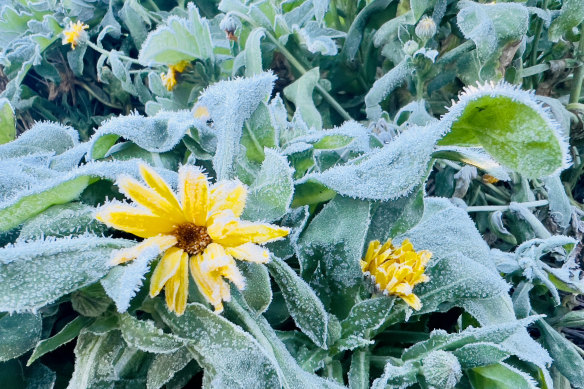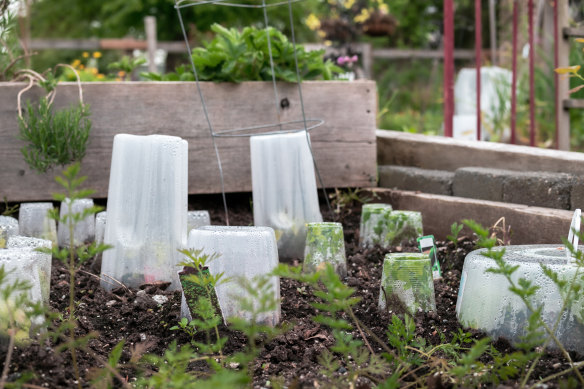Why the last frost of the season is important for your garden
Let’s not get ahead of ourselves just because we’ve had warm sunny spells and it’s not even the end of August. When it comes to frost, we’re not out of the woods yet.
There might be blossoms on almonds, buds on plums and new leaves on mulberries, but that doesn’t mean icy blasts of winter are entirely behind us.

Frost dates for the year are important markers on the gardening calendar.Credit: Getty Images
Depending on where you garden, frost might still be headed your way. Final frost dates have always varied widely across Australia and, while climate change has brought less frosty weather to some parts of southern Australia, it is stretching the frost window for others. Some frosts, it seems, are coming both earlier and later.
Being a localised phenomenon, it’s hard to make blanket statements, but while Sydney’s last frost for the year has likely already happened – early August is usually as late as frost gets there – outer areas of Melbourne run the chance of frost until early September. Hobart can be frosty even further into September and all rural areas might get later frost still.
Whatever your situation, the first and last likely frost dates of the year are important markers on the gardening calendar. They can influence what you do as much as any other aspect of your local climate.
Anyone hankering to get a head start with zinnias, zucchinis and other hot-weather fare should bear the risk of frost in mind.
The silver glint of morning ice crystals might look very luminous, but they have a dark side. Frost, which usually strikes on still, clear nights when the atmosphere is very dry, can be especially tough on young seedlings. First, the crystals form all over the leaves and stems, then the frost causes a plant’s insides to freeze. As these internal ice crystals expand, delicate plant tissue starts ripping apart.
The extent of the damage will depend on how quickly the temperature drops to zero and how long the freezing conditions last. Damage across the garden will also vary because not all plants respond to frost in the same way. Some trees and shrubs sail through it. Even the vegetable patch can derive benefits.
Give carrots, parsnips, brussels sprouts and kale a dose of frost and they produce sugars that only make them sweeter. Just as the pomelo and other tropical fruits need high heat for good flavour, these foods need deep cold.
But on the other side of the equation are those plants that frost turns to mush. Frost and tomatoes, capsicums, chillies, eggplants, zucchinis, cucumbers, basil, lovage, Malabar spinach, zinnias and some rudbeckias, for example, do not go hand in hand.
Now is the time when you might think about sowing the seeds of these plants indoors. No matter the weather outside, with heat mats and big windows even the most sun-loving edibles and flowers can germinate in late August.
You will then need to ply the emerging seedlings with light, warmth and water, with a view to hardening them off (by reducing temperature and water) and transplanting them outside once the soil temperature is at least 20 degrees and all danger of frost has passed.
At the other end of the hottest months, you need to harvest all your produce before the weather cools again because the first frosts of autumn will likely bring this summer show to a halt.

Smaller plants can be protected from frosts with plastic containers or guards.Credit: iStock
Those with particularly short frost-free growing seasons will do best with varieties that give good yields over a relatively contained period, such as some determinate tomatoes that can produce fruits within two months of being transplanted outside.
Getting a yield of ripe tropical fruits, such as custard apples and cherimoyas, can also prove tricky in cooler climates because the fruit might not be ripe before the first frosts of autumn. Even though the tree will survive some frost, these fruits will not. One option is to bag them individually ahead of cold weather.
As for the rest of the garden, smaller plants can be protected from frosts with plastic tree guards or, at night, upturned cardboard boxes. Another way to minimise frost damage is to remove mulch from around plants, as the bare earth absorbs more heat during the day, some of which is released into the air at night.
Water also holds heat, with well-watered soils having a more insulating effect than dry ones. Something else to bear in mind is microclimates. Every garden has spots that are warmer than others – including areas against north-facing walls and raised beds – and these are especially useful for your most frost-tender plants.
It’s getting warmer, but gardeners should still be prepared for everything.
Make the most of your health, relationships, fitness and nutrition with our Live Well newsletter. Get it in your inbox every Monday.